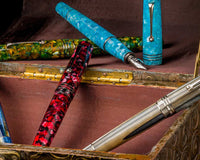Every year during springtime, like hundreds of thousands of other families, my family gathers for the Easter Holiday. The kids hunt for candy-filled eggs, we have a nice dinner, we swim, and we always make sure to dye Easter eggs that will later be made into the most delicious deviled eggs in the world. However, due to the pandemic, my family, along with all other families, won’t be able to gather and celebrate Easter together. Because of this, I decided to do a little Easter celebration with you, my fountain pen family! We are going to dye Easter eggs using fountain pen inks! In this article, I will walk you through the steps I took to dye my eggs. Now, let’s sit back, gather around the table, and dye some eggs!
Supplies Needed
- ¾ cup water per glass
- 1 tsp. white vinegar per glass
- White hard boiled eggs (shell on)
- Your choice of festive fountain pen inks
To start off with this very fun project, you will first need to prepare your cups for dying. I used ¾ of a cup of water in each glass, along with 1 teaspoon of white vinegar per glass.
Then, you need to get your fountain pen inks! To each cup of water/vinegar mixture, I added 2mL of ink using a blunt-tipped syringe. If you want darker dyed eggs, use closer to 3mL of ink. For lighter eggs, use 1.5mL.
I used 5 inks to dye 4 eggs, but you are free to use as many inks on as many eggs as you’d like. For my inks, I chose to use LAMY Crystal Azurite, Anderillium Spirula Green, Diamine Wild Strawberry, Pilot Iroshizuku Tsuyu-Kusa, and Pilot Iroshizuku Kon-Peki. I dyed one egg with half Tsuyu-Kusa and half Kon-Peki to be able to do a quick comparison between the two, seeing as Tsuyu-Kusa is very close to being a less-saturated version of Kon-Peki.
I left each egg in their respective cups of dye for about 30 seconds. When I pulled them out, they were all far less saturated than the inks the eggs were dyed with are on the page. Like I said before, you can adjust how light or dark your eggs come out by changing the amount of ink you put in each cup. You can also keep the eggs in the dye mixture for longer than 30 seconds to get a darker egg. That being said, I am very happy with the color and saturation each that my eggs came out with.
The LAMY Azurite dyed egg came out as a beautiful dark periwinkle. It looks nothing like the ink it was dyed in, but it is a truly gorgeous color.
The Anderillium Spirula Green dyed egg came out much closer to the actual color of the ink, just a lot lighter. It’s a great pastel green that will go well with any springtime feast.

The Diamine Wild Strawberry dyed egg came out as a nice, pastel pink. Like the green egg, it fits in perfectly with the spring aesthetic.

As for the two Pilot Iroshizuku inks, I had some very interesting results. The half of the egg that was dyed with Tsuyu-Kusa came out very light and pastel. For some people, it might be too light, but I think it adds the perfect amount of blue pop to this little collection of pastel eggs that I now have. The half that was dyed with Kon-Peki came out a very beautiful light teal color. The Kon-Peki half has far more green undertones in it than the Tsuyu-Kusa half of the egg. The color of the Kon-Peki half reminds me a lot of a robin’s egg.

All in all, this was a very fun and interesting project for me to do. The fact that fountain pen ink actually worked as an egg dye alternative is a win in my book. The eggs looking as great as they do is just an added bonus! I am very satisfied with how mine turned out, and I think you will be just as satisfied with your own Easter eggs! If you end up doing this experiment, please let me know how your eggs turned out in the comments below. Additionally, don’t forget that all email subscribers get an extra 10% off of their purchases from endlesspens.com with my discount code “ARLO10.”
Written by EndlessPens Blogger Arlo Palmer








1 comment
Micki
Are the eggs edible after using FP inks to dye with?